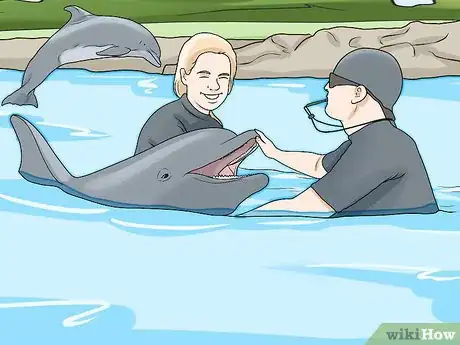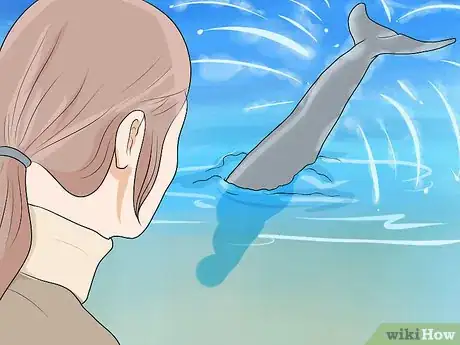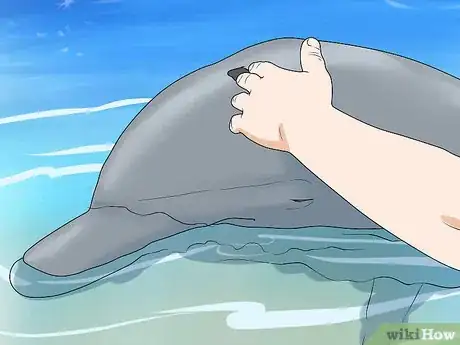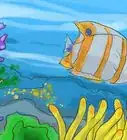wikiHow is a “wiki,” similar to Wikipedia, which means that many of our articles are co-written by multiple authors. To create this article, 29 people, some anonymous, worked to edit and improve it over time.
This article has been viewed 49,747 times.
Learn more...
Dolphins are intelligent, social animals, who are rightly admired by people around the world. In controlled environments with trained animals, it is possible to pet a dolphin carefully. In the wild, petting a dolphin can be dangerous for the human and disruptive to the life of the dolphins. However, with some care, we can also watch them in their natural habitat.
Steps
Finding Dolphins
-
1Find a guided tour. If you have the time and money this is perhaps the best option. In many warm weather locales there are guides who, for a fee, will take you to a local group of dolphins and help you interact with them. Often such tours are led by scientific experts who can teach you or your children about our dolphin friends and their habitat.
- Examples of such programs include: Discovery Cove in Orlando; Dolphin Quest in Hawaii; Dolphinaris in Cancun; Dolphin Cay in the Bahamas; and the Dolphin Research Center in Marathon, Florida.[1]
- If you did go on a guided dolphin tour, verify that it is legitimate and has a good safety record.
-
2Visit an aquarium. Sometimes you can pet dolphins without making a long hike to the ocean by visiting the local aquarium. The National Aquarium offers special packages for those who want to get close to a dolphin under professional supervision. The same is true for some theme parks, like SeaWorld.[2]Advertisement
-
3Go to the beach. Dolphins can be found in oceans throughout the world. Some places, however, are better than others for finding wild dolphins. The Azores has the greatest variety of dolphin species and dolphins there frequently come close to shore. New Zealand and the Bahamas should also be on the top of the list for any tourist hoping to see dolphins in their natural habitat.
- While visiting a beach alone, keep your distance from dolphins. You can appreciate them from afar, but will put yourself at risk if you approach too close.
-
4Support dolphin life. While it might seem like more fun to swim with the dolphins, the best way to interact with a dolphin is to protect them from danger. Some species of dolphin are endangered due to overfishing, global warming, and human encroachments on their habitat.[3] Through a conservationist group you can adopt a dolphin, get updates on dolphin issues or lobby government to protect endangered species.
Engaging with Dolphins
-
1Research the law. In some places, humans try to interact with dolphins so frequently that it disrupts their natural behavior. As a result, it is illegal to feed or approach a wild dolphin in many countries, including the United States. Dolphins are large, powerful creatures that can and occasionally do hurt humans. Restrictions on human-dolphin interaction, therefore, are typically in the interest of both parties.[4]
-
2Get into the water with dolphins and a qualified guide. If you are visiting dolphins in their natural habitat, get into the water no less than fifty feet from them. You should never attempt to approach a dolphin alone. Better yet, do this with someone who is properly trained to interact with wild dolphins and knows how to read dolphin reactions.
-
3Do not approach the dolphin. Let the dolphin approach you. Dolphins are easily scared and may get defensive and territorial. They will view you swimming up to them as aggressive behavior. While you might feel the urge to approach them, they are more likely to be friendly if they find you to be non-threatening.
-
4Watch for signs of distress. If the dolphins are smacking the water with their tail, leaping and spinning or exhaling loudly in quick bursts, they are probably agitated. Back away and consider leaving the area. Dolphins can be dangerous if aggravated.[5]
- Leave immediately if you see a mother with small babies. Such an interaction can cause considerable distress.[6]
- Also pay attention to swimming patterns. If the dolphins are diving for an extended period of time or if they are making abrupt changes in the speed or direction of their swimming that are probably upset.[7]
-
5Be careful not to hurt the dolphin. When touching dolphins in captivity, be aware that they are sensitive. Their skin is delicate and can easily be hurt by our fingernails. Areas that are particularly sensitive include the blowhole, eyes, snout, lower jaw, and melon.
- Petting a dolphin in the wild is not recommended. While watching a dolphin from a distance might be alright, any invasive activity might scare the dolphin away from its natural habitat. Stay at least fifty feet away and leave within thirty minutes[8]
-
6Watch from a distance. Unless you are in a controlled setting with a guide who says otherwise, you should keep your distance and watch the dolphins in their natural habitat. You should feel free to do this, either snorkeling or in a boat. As long as you do no see any of the aforementioned signs of agitation and do not stay in their space for more than thirty minutes, the interaction should be safe for all parties.
Community Q&A
-
QuestionWhat is the cost of owning a dolphin?
 Community AnswerTheoretically you could get one free out of the ocean. Realistically you would have to have about $10,000 a month to keep him fed, happy, and safe. You would also have to pay a big fine if you're caught with it.
Community AnswerTheoretically you could get one free out of the ocean. Realistically you would have to have about $10,000 a month to keep him fed, happy, and safe. You would also have to pay a big fine if you're caught with it.
References
- ↑ https://www.foxnews.com/travel/6-places-to-swim-with-dolphins
- ↑ http://www.orlandosentinel.com/business/tourism/os-seaworld-dolphin-feeding-20150223-story.html
- ↑ http://www.seethewild.org/dolphin-threats/
- ↑ http://www.scubadiving.com/training/advanced-skills/seaview-5-rules-interacting-wild-dolphins
- ↑ http://www.scubadiving.com/training/advanced-skills/seaview-5-rules-interacting-wild-dolphins
- ↑ http://www.blue-world.org/en/dolphin-watching/
- ↑ http://www.blue-world.org/en/dolphin-watching/
- ↑ http://www.blue-world.org/en/dolphin-watching/
About This Article
To pet a dolphin, avoid petting them in the wild, since touching them incorrectly can cause injuries. Instead, visit the National Aquarium or Sea World, which offer packages where you can pet dolphins under professional supervision. If you’re in a warm weather location, try purchasing a tour with a professional guide, such as Discovery Cove in Orlando or Dolphin Quest in Hawaii. Once you’re in the water, wait for the dolphins to approach you, since they may feel threatened by you moving towards them. For tips on how to adopt a dolphin, read on!




































































